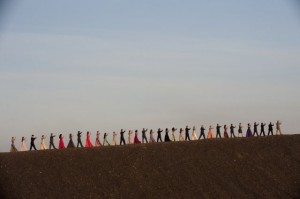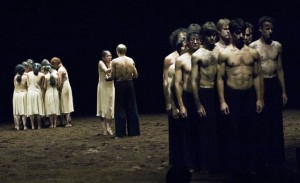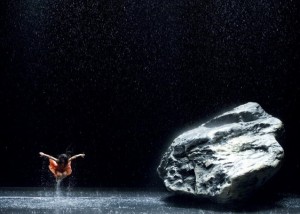
Another barely-in-time-to-catch-it-before-the-awards Oscar contender arrives in town this week with Wim Wenders’ Pina, which is up for Best Documentary. Whether it actually fits the frequently slippery definition of documentary is a question that’s been raised, but I’m not sure what else you’d call it. Still, its capturing of a number of dance creations by the late Pina Bausch—sometimes taking them off the stage and into other settings—is probably not the first thing that comes to mind when you encounter the term “documentary.” Whatever the case, this is a frequently remarkable, always interesting film with some of the best—and most unusual—use of 3D I’ve encountered.
Film fans who are not up on modern dance (and I’m in that group) may have some passing familiarity with Bausch, because part of her ballet Café Müller was used in Pedro Almodóvar’s Talk to Her (2002). The ballet’s images of characters blindly walking through a setting in which chairs and tables were constantly rearranged perfectly fit the themes of Almodóvar’s film. Presented more fully here than in the earlier film, Café Müller is just one of the Bausch creations showcased in Pina.

The film we have isn’t the one Wenders had intended to make. His plans were originally for a film made with Bausch and not about her, but Bausch succumbed to cancer just before the film started shooting. Her death hangs over the mood of the film, specifically in the interview footage with her dancers and in Wenders’ decision to use the credit “A Film for Pina Bausch by Wim Wenders.” What hangs over the dance pieces themselves is not a sense of death, but one of life—even if the dance set to Louis Armstrong’s recording of “West End Blues,” which runs through the film like a motif, ultimately echoes the dance of death at the end of Bergman’s The Seventh Seal (1957).

It’s close to futile to try to describe dance. It’s an area where words break down—as the film itself makes clear. (I kept flashing back on the line in Ken Russell’s Mahler where the composer says, “If I could tell you the answer in words, there’d be no need for me to compose music.”) What can at least somewhat be described are the unusual and often complex stagings—like the dirt-covered stage for her production of Stravinsky’s Rite of Spring in which the dancers themselves become covered in earth, suggesting the primitive nature of the work in an almost shocking way. (This is one of the works that Wenders wisely does not “open up” by taking it out of the stage setting.)

Also of note is the ballet Vollmond, in which an actual waterfall is created onstage. It is in the waterfall and pool that the dancers perform (no mean feat in itself), and the water becomes a part of the movement. These are not your usual dance works—though traditional ballet is satirized on occasion. I admit I responded best to dances that were performed to pieces of music I was familiar with—“West End Blues,” Rite of Spring, Tchaikovsky’s Sixth Symphony—but the overall force of the film’s images and the intelligent and striking use of 3D carried the film for me. (I didn’t even mind having to be at the theater at 8:45 a.m. to screen it … much.) Whether you’re into modern dance or not, this is well worth seeing. Rated PG-13 for sensuality, nudity and smoking.



Before you comment
The comments section is here to provide a platform for civil dialogue on the issues we face together as a local community. Xpress is committed to offering this platform for all voices, but when the tone of the discussion gets nasty or strays off topic, we believe many people choose not to participate. Xpress editors are determined to moderate comments to ensure a constructive interchange is maintained. All comments judged not to be in keeping with the spirit of civil discourse will be removed and repeat violators will be banned. See here for our terms of service. Thank you for being part of this effort to promote respectful discussion.